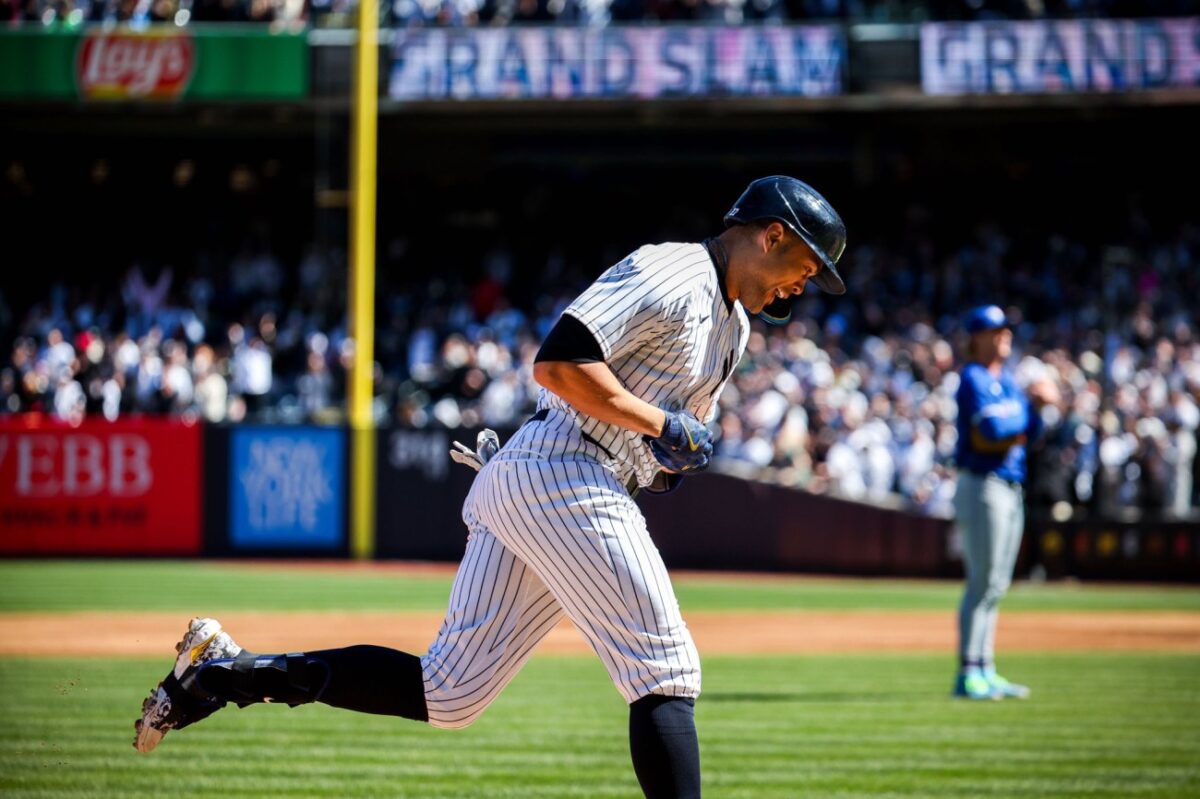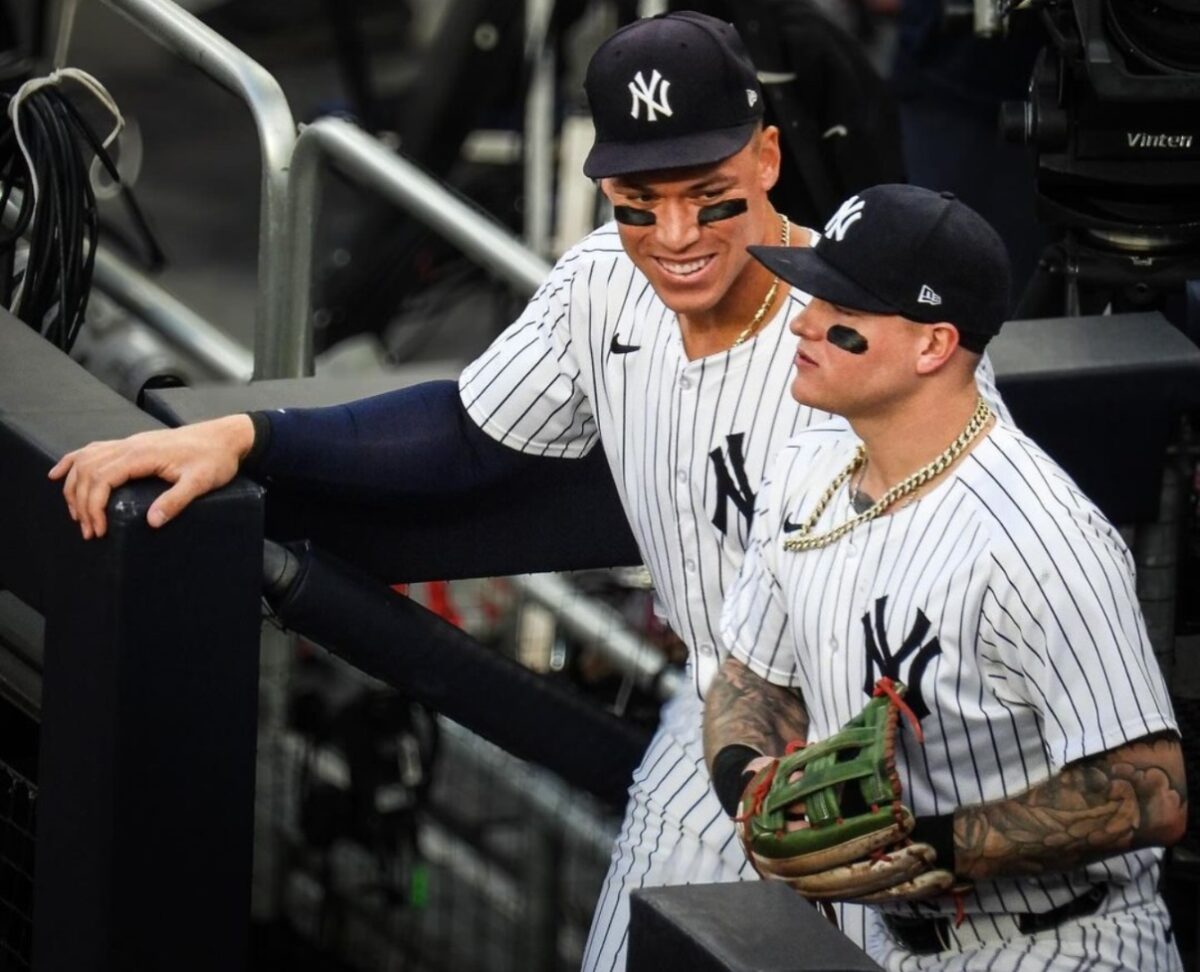Boone on Stanton throttling Yankees: ‘Something you kind of have to live with’


Inna Zeyger
More Stories By Inna Zeyger
- Mother’s Day: How Anthony Volpe’s mom molded him into a Yankee phenom
- Steinbrenner ‘got ears’ to hear Yankees’ challenges, yet no gurantee of change
- Michael Kay’s show heading to December ending amid uncertainty over ESPN deal
- Yankees’ Gleyber Torres projected to sign with NL West contender
- Yankees keeping tabs on Santander while Soto decision looms, says insider
Table of Contents
In Game 1 of the ALDS, Giancarlo Stanton‘s slow speed on the basepaths proved detrimental for the New York Yankees, potentially costing them two runs. Statcast data from the regular season ranked him as the 284th fastest player out of 288 who had at least 100 competitive sprints.
In the fourth inning, with two outs and Stanton on first, Oswaldo Cabrera hit a double to right-center field. Despite a misplay by Royals center fielder Kyle Isbel, the Yankees slugger was unable to score and was held at third base, leaving the Yankees without capitalizing on the scoring opportunity.
Later in the sixth inning, with the score tied at 5-5, Stanton grounded out to third baseman Maikel Garcia. Although Garcia had to make a diving stop, he had ample time to set himself and throw out the Yankees star at first base. Stanton’s sprint speed on that play was measured at just 25.5 feet per second, which would have ranked as only his ninth-fastest speed during the regular season.

When asked about executing baserunning strategies with a player appearing to run at “half speed,” Yankees manager Aaron Boone defended Stanton’s pace. He explained that Stanton’s running style is a controlled gait, adopted to minimize injury risk. Boone noted that Stanton has experienced setbacks from sudden changes in speed, and this measured approach is something the team must accept.
Boone highlighted Stanton’s history of hamstring injuries, including one suffered this summer while running the bases and another from the previous season when he pushed himself harder than usual on a double. The Yankees manager emphasized that this speed has become Stanton’s norm at this point in his career.
“He’s more than half,” the Yankees manager admitted. “It’s a controlled gait that he knows he has to get into. He’s burned himself when he tries to throttle back up or down. That’s when he knows he’s been (compromised). It is something you kind of have to live with. Whether you’ve seen it over the years with a particular player who is incredibly slow but still impactful, it’s just something we have to accept. He’s got to do what he’s got to do. He’s trying to reach his top speed in the most fluid way he can.”
The Yankees skipper acknowledged that Stanton is trying to reach his maximum speed as smoothly as possible, given the limitations they face. In Game 1, Stanton finished 0-for-4 with one walk. Boone’s remarks suggest that if Stanton is not producing home runs and slugging, his limited baserunning ability could become a liability for the team.
Boone confirms Verdugo for Yankees’ ALDS Game 2

Manager Boone announced that Alex Verdugo would remain in the Yankees’ left field for the upcoming game, following his impressive performance in Game 1 of the ALDS. This decision comes amid earlier speculation that the left field position might be shared between Verdugo and rookie Jasson Domínguez throughout the playoffs.
Verdugo’s efforts in Game 1 validated the Yankees’ trust in him. He went 2-for-3 at the plate, walked once, and delivered the decisive RBI single in the seventh inning. Additionally, he showcased his defensive skills with two standout plays that garnered praise from teammates in the dugout.

Boone revealed that he had informed Verdugo of his start several days in advance, though this information had not been disclosed to the media. Verdugo faced criticism from fans during player introductions, primarily due to a disappointing regular season that saw him post a career-low OPS+ of 83.
Holmes sets stage for Weaver to secure Yankees’ win
In ALDS Game 1, the Yankees won largely thanks to the stellar performances of their bullpen. Clay Holmes, the former closer, demonstrated his playoff prowess by securing five crucial outs in the middle innings. Luke Weaver, Holmes’ successor as closer, then sealed the victory with a four-out save in his postseason debut.
Holmes, who has yet to concede a run in his postseason career spanning 9 ²/₃ innings, expressed admiration for Weaver’s performance. He acknowledged the challenges of pitching multiple innings in high-pressure situations, emphasizing the significant boost Weaver’s contributions have provided to the team.
“It’s not easy, those last three outs,’’ he told on Saturday. “To come in [to the dugout] and cool down and go back out is hard. What he’s doing has been a huge boost for the team.”
The bullpen’s importance was underscored when starter Gerrit Cole struggled through five-plus innings. Holmes entered the game in a precarious situation, inheriting runners on second and third with one out. Despite allowing an infield single, he navigated through the danger, keeping the Yankees within striking distance.
After the Yankees tied the game, Holmes continued his strong outing, retiring dangerous hitters including Vinnie Pasquantino. His efforts set the stage for the Yankees to take the lead on Alex Verdugo’s timely hit.
Weaver then took over, efficiently retiring four batters, including the heart of Kansas City’s lineup, to secure the win.
What do you think? Leave your comment below.
- Categories: alex verdugo, Clay Holmes, Giancarlo Stanton, jasson dominguez
- Tags: alex verdugo, Clay Holmes, Giancarlo Stanton, jasson dominguez
Related posts:


 Follow Us
Follow Us









